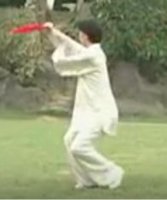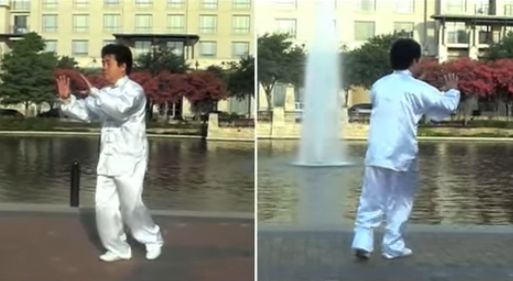I am loving Hua Wu Fan, now learning section three, which includes the Weeping Willow, the Drunken Beauty and the Moon Goddess, Cháng’é, who flies to the moon (below):

Here are the names for the third section:
- 迎月花开 Yíng yuè huā kāi: Flower Opens to the Moon
- 白蛇吐信 Bái shé tǔ xìn: White Snake Sticks out its Tongue
- 玉女穿梭 Yùnǚ chuān suō: Fair Lady Works the Shuttles
- 迎风掸尘 Yíng fēng dǎn chén: Face the Wind and Brush Away Dust
- 海底捞针 Hǎi dǐ tàn zhēn: Search the Bottom of the Sea
- 二龙戏珠 èr lóng xì zhū: Two Dragons Play with a Pearl
- 青蛇出洞 Qīng shé chū dòng: Bluegreen Snake Leaves the Cave
- 倒挂垂柳 Dàoguà chuíliǔ: Weeping Willow Hangs Down
- 贵妃醉酒 Guìfēi zuìjiǔ: The Drunken Beauty [Beijing Opera!]
- 嫦娥奔月Cháng’é bènyuè: Moon Goddess Flies to the Moon
- 拨云观日 Bō yún guān rì: Part the Clouds to See the Sun
- 蛟龙翻身 Jiāolóng fānshēn: Flood Dragon Turns Over
According to Pengyou Taiji Quan (Friends of Tai Chi), Zhongji Hua Wu Shan is taught at the Huawu Gongfu Centre (no website) in Fuzhou, capital of Fujian Province in China, north of Guangdong, south of Shanghai.
I’ve noted elsewhere that this form was created by martial arts coach Zeng Nai Liang and Hu senior lecturer Wei Xianglian. I see that Master Zeng, one of the top ten martial arts coaches in China, visited Jason Leung’s academy right here in Texas in 2011. So sorry I missed that!









 2.
2. 3.
3.  4.
4. 5.
5. 6.
6. 7.
7. 8.
8.


